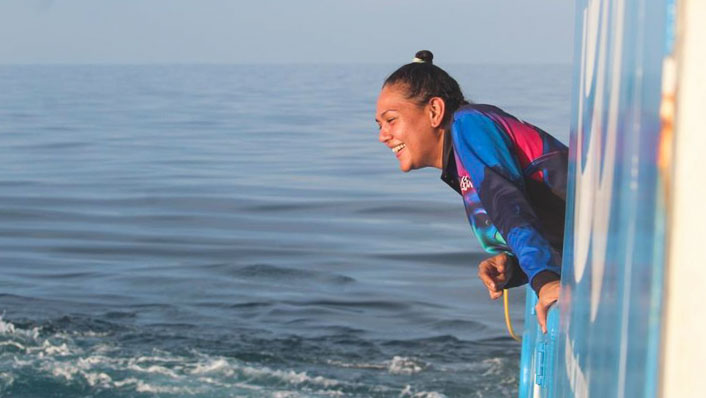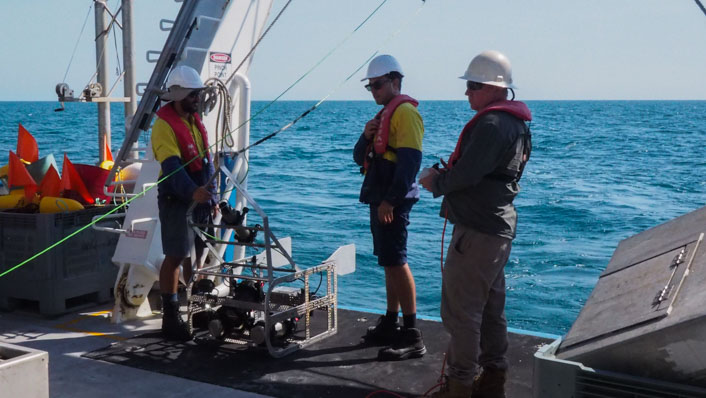AIMS scientists were joined by Parks Australia and Traditional Owner Rebecca Williams on a recent expedition to unlock the secrets of this remote area in the Gulf of Carpentaria
AIMS’ research vessels are equipped to take our scientists to some of Australia’s most remote and underexplored regions to help unlock their secrets. But it is our human connections that help us deepen our understanding of our submerged heritage and biodiversity in areas like West Cape York Marine Park.
Situated off the Queensland west coast in the Gulf of Carpentaria, there is limited scientific knowledge about areas of this marine environment, that is managed by Parks Australia. AIMS scientists had only made the journey once before with CSIRO and Reef Life Survey to one area – the Carpentaria Shoal.
So this latest, longer trip for 10 days allowed the researchers to map the sea floor and conduct surveys at three locations – Carpentaria Shoal, Merkara Shoal and an area of unusual pockmarks in the seafloor that was detected near Carpentaria Shoal on a previous voyage.

Cultural knowledge shared
Joining AIMS on the Research Vessel Solander were Alex Tomlinson from Parks Australia and Traditional Owner Rebecca Williams from the Angkamuthi People. As observers, they were there to witness and help with the various surveys. Ms Williams was also able to share her cultural knowledge of the region, passed down through generations of the Angkamuthi people.
While the areas the team visited might have been unmapped and unexplored by western scientists, Ms Williams said the features were known to Traditional Owners.
“All my life, I’ve been told about sand movements, where to find certain sharks and certain fish in this area of Sea Country by the older people, including my grandfather. And from what I saw on this trip, their deep knowledge and understanding was reflected back to me, which was very satisfying,” said Ms Williams.
“I have come to understand this area through stories and myths, passed down through generations of my people, but to see the shoals and marine life via the footage we captured with my own eyes was very special. I think because of the sand movements, these areas were not visited by Angkamuthi people very often.
“It was also very interesting to experience the working of the Solander and see up close how the AIMS scientists gather data. I helped prepare the BRUVS before they were deployed and got to fly a Towvid over the seafloor. There was an exchange of knowledge between us throughout the trip, both scientific and cultural that was valuable for us all.
“It is very important to combine western science and cultural knowledge so we can make the right decision to maintain and preserve a sustainable future.”
The scientific objectives of the 10-day voyage were to improve baseline information on seafloor habitats in these parts of the marine park and fill knowledge gaps such as the occurrence and abundance of species. The data collected will help the collaborators understand the conservation needs of the marine park and assist Parks Australia in maintaining its natural values in the future.

Marine Park values
West Cape York Marine Park protects part of one of the largest seagrass meadows in Australia, providing year-round grazing for dugongs and turtles. It also includes extensive tidal banks and offshore reefs.
Parks Australia’s Mr Tomlinson stressed the importance of Traditional Owners and scientists working together to understand Australia’s marine parks more fully.
“This was a collaboration that will help us all better understand the cultural and scientific value of this marine park. Both values are as important as each other,” he said.
“By doing this together, we were able to learn from each other and we are better equipped to investigate this area in a more holistic way.”
AIMS’ Matt Birt, who was the cruise leader on the trip, agreed, and added that sharing knowledge with Rebecca was a highlight.
“The stories she told us from the Traditional Owner perspective, especially her grandfather’s experiences of the area, gave us an incredible insight and made us realise some of these areas might not be as little known as we imagined,” he said.
“Our surveys and mapping showed some really interesting and complex features at the three sites we visited and I’m looking forward to seeing the full analysis of these areas.”






